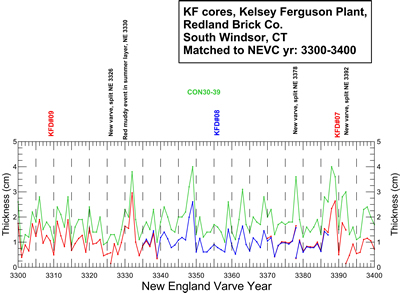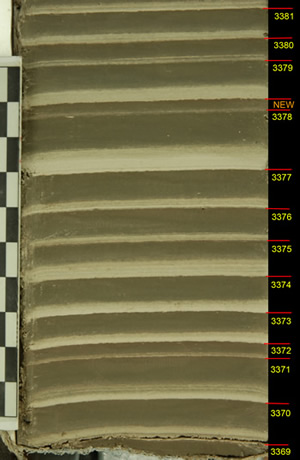Varves of the Month for 7/1/2010 - 7/31/2010
Varves from Redlands Brick Co. (Kelsey Ferguson Brickyard, South Windsor, Connecticut) - A varve that Antevs missed
This month's varves are thin and relatively clayey varves from the old Kelsey Ferguson Brickyard (now Redlands Brick Co.) in South Windsor, Connecticut. The varve image is a magnified view of an outcrop core that has been partially dried to make the summer and winter layers more easily discernable. This outcrop has been matched to the New England Varve Chronology and numbers on the image (3369-3381) are varve years in that chronology. A plot of the outcrop core from which the image was taken and adjacent overlapping cores is also shown below. (How to collect outcrop cores). The varves on the image were deposited in an environment distal to the receding ice front that was about 30 km to the north (near Chicopee, Massachusetts) at the time of deposition (~17,500 yr ago).
The varves shown here are typical of some ice-distal varves with winter layers thicker than summer layers. There is a very well pronounced positive correlation between winter and summer layer thickness suggesting that: 1) winter layer clay (dark layers) was introduced to the lake during the summer and 2) time was not a factor in determining the thickness of winter layers. All of the summer layers have faint traces of laminations in them that represent melting or storm events during the summer. The varves are too thin to see a distinction between early, main, and late melt season layers and the melt season (summer) likely represents just the main melt season with early and late melt season transport not contributing to the varves. Even on this magnified image there appears to be a relatively sharp change from summer to winter layers without the gradation often seen in thicker varves. Varves of this type have been called diatactic varves. Winter layers in the varves show a faint gradation in color from olive gray at the bottom to gray with a reddish brown tint near the top. This faint color change appears to be gradational and probably reflects grain size gradation (decreasing upward) in the winter layer with iron oxide pigments settling later in the winter than gray clay, which may have started to flocculate immediately after the melt season.
Ernst Antevs counted and measured varves from this time in constructing the New England Varve Chronology and all his measurements were made at moist outcrops. When thin clayey varves are moist the visual separation of varves is sometimes difficult. In fact, it appears that Antevs missed a varve (marked NEW between 3378 and 3379) on this image measuring the varve as part of the winter layer of varve 3378. In new cores this same varve has also been seen to the south at Glastonbury and to the north at Scantic (East Windsor), Connecticut. Also note that Antevs did measure a varve (3372), which is nearly as thin as the one he missed.

Plot of the New England Varve Chronology for varve years 3300-3400. Shown is Antevs original “normal curve” for northern Connecticut (green, CON30-39) with matches of outcrop cores collected at the Kelsey Ferguson Brickyard including KFD#09 to KFD#07 (red and blue). The image of varves above shows 3369-3381 in core KFD#07. Click on image to download original file.
On the varve plot this position in the varve chronology is shown with two couplets that will force the splitting of varve 3378. Similar situations also exist at varves 3326 and 3392. Thus, this 100-yr plot of Antevs original chronology actual has three more varves (years) than originally counted by Antevs. Errors of this type are much more common in this area of Connecticut where the varve sections measured by Antevs were composed of thin clayey couplets.
Part of the mission of the North American Glacial Varve Project has been to update the New England Varve Chronology. In the coming month a reformulated varve chronology will be posted that incorporates corrections to the varve sequences, like the one shown here, and joins the two main independent sequences of the old New England Varve Chronology into a unified and corrected numbering system. This new chronology is just being completed and will be called the North American Varve Chronology. This new name will also better reflect the incorporation of varves from New York State and in the future other areas outside New England.
Past Varves of the Month...
- 6/1/2008 - Connecticut Valley Varves at Canoe Brook, Dummerston, Vermont
- 4/27/2008 - Connecticut Valley Varves from Kelsey Ferguson Brickyard, Redland Brick Co., East Windsor, Connecticut.
- 7/1/2008 - Champlain Valley varves at Keesville, NY
- 8/1/2008 - Connecticut Valley Varves at Aldrich Brook, Westmoreland, New Hampshire
- 9/1/2008 - Connecticut Valley Varves, Perry Hill Basin (PHS), Charlestown, New Hampshire
- 10/1/2008 - Connecticut Valley Varves, Perry Hill Basin (PHN), Charlestown, New Hampshire.
- 11/1/2008 - Connecticut Valley Varves, Aldrich Brook site, Westmoreland, New Hampshire
- 12/1/2008 - Connecticut Valley Varves, Aldrich Brook site, Westmoreland, New Hampshire
- 1/1/2009 - Mine fire reclamation site, Olyphant, Pennsylvania
- 2/1/2009 - Connecticut Valley Varves, Perry Hill Basin (PHS), Charlestown, New Hampshire
- 3/1/2009 - Connecticut Valley Varves, Perry Hill Basin, Charlestown, New Hampshire
- 4/1/2009 - Connecticut Valley Varves, Perry Hill Basin, Charlestown, New Hampshire.
- 5/1/2009 - Connecticut Valley Varves, Perry Hill Basin, Charlestown, New Hampshire
- 6/1/2009 - Connecticut Valley Varves, Perry Hill Basin, Charlestown, New Hampshire
- 7/1/2009 - Connecticut Valley Varves, Perry Hill Basin, Charlestown, New Hampshire
- 8/1/2009 - Connecticut Valley Varves, Perry Hill Basin, Charlestown, New Hampshire
- 9/1/2009 - Connecticut Valley Varves, Perry Hill Basin, Charlestown, New Hampshire
- 10/1/2009 - Connecticut Valley Varves, Perry Hill Basin, Charlestown, New Hampshire
- 11/1/2009 - Connecticut Valley Varves, Perry Hill Basin, Charlestown, New Hampshire.
- 12/1/2009 - Connecticut Valley Varves, Perry Hill Basin, Charlestown, New Hampshire
- 1/1/2010 - Connecticut Valley Varves, Perry Hill Basin, Charlestown, New Hampshire
- 2/1/2010 - Varves along Starrucca Creek near Lanesboro, Pennsylvania
- 3/1/2010 - Varves in the Don Valley, Toronto
- 4/1/2010 - Varves along Sandy Stream, Dennistown Plantation near Jackman, Maine
- 5/3/2010 - Varves from Glacial Lake Great Falls in Montana
- 6/4/2010 - Varves from Charlestown, NH
- 8/1/2010 - Varves from Glastonbury, Connecticut
- 9/1/2010 - Varves from North Hatfield, Massachusetts
- 10/1/2010 - Varves from Newbury, Vermont
- 11/1/2010 - Varves from Newbury, Vermont
- 12/1/2010 - Varves from Newbury, Vermont
- 2/1/2011 - Connecticut Valley Varves at North Hatfield, Massachusetts
- 3/1/2011 - Connecticut Valley Varves Kelsey Ferguson (Redlands Brick Co.), South Windsor, Connecticut
- 6/1/2011 - Connecticut Valley Varves: Core at Scantic, East Windsor, Connecticut
- 8/1/2011 - Varves of West Canada Creek Valley, western Mohawk Valley
- 10/1/2011 - Varves of West Canada Creek Valley, western Mohawk Valley collected in Newport, NY
- 12/1/2011 - Connecticut Valley Varves at Claremont Junction, NH
- 3/1/2012 - Connecticut Valley Varves at Westmoreland, NH
- 7/1/2012 - Connecticut Valley Varves at Rt. 12A drill site in North Charlestown, N.H.



